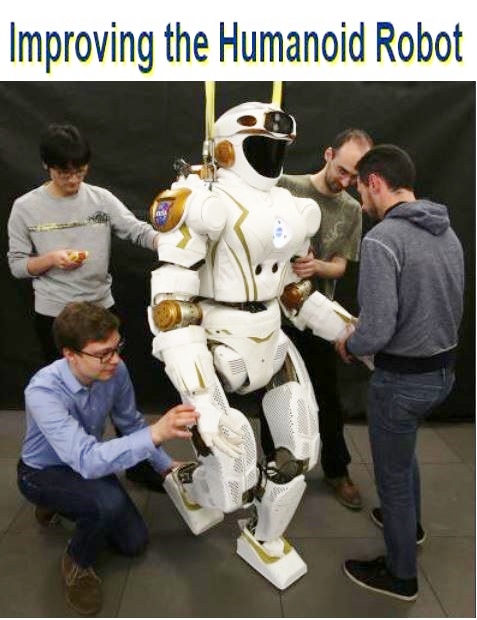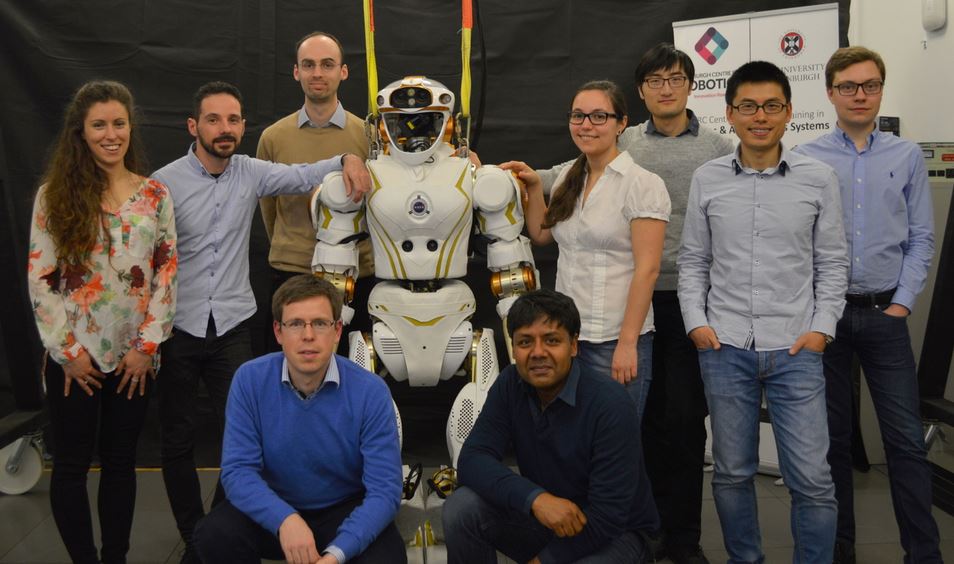A humanoid robot is being developed by Edinburgh scientists and NASA in preparation for Mars missions. The robot – called Valkyrie – is 1.8 metres (6ft 11ins) tall and weighs 125 kg (275 lbs or 19.7 stones). In Norse mythology, a Valkyrie is one of a host of female figures who select those who may die in battle and those who may live.
The roboticists will try to improve the computational and physical abilities of Valkyrie, a humanoid machine that is able to walk on two legs and carry out basic movements, such as manipulating and holding objects.
 According to the University of Edinburgh: “The NASA Valkyrie is one of the most advanced humanoid robots in the world. The robot was constructed by NASA-JSC in 2015 and delivered to the University of Edinburgh in Spring 2016. Weighing 125 kg and standing 1.8m tall, Valkyrie will enable breakthroughs in humanoid control, motion planning and perception.” (Image: valkyrie.inf.ed.ac.uk)
According to the University of Edinburgh: “The NASA Valkyrie is one of the most advanced humanoid robots in the world. The robot was constructed by NASA-JSC in 2015 and delivered to the University of Edinburgh in Spring 2016. Weighing 125 kg and standing 1.8m tall, Valkyrie will enable breakthroughs in humanoid control, motion planning and perception.” (Image: valkyrie.inf.ed.ac.uk)
The aim is to provide the robot with a considerably more sophisticated set of skills, so that it can understand and better respond to its surroundings.
Improved capabilities
Professor Sethu Vijayakumar, Chair of Robotics, School of Informatics and Director, Edinburgh Centre for Robotics, and colleagues will try to improve the robot’s walking capabilities and handling.
They will use Valkyrie’s sophisticated on-board sensors to improve its manoeuvrability and make sense of its environment.
The researchers will also try to further develop Valkyrie’s ability to interact safely and closely with other machines and human beings.
What is a robot?
Developed for space travel
It is the only robot of its type in Europe, the researchers say, and one of just three prototypes globally.
 PhD students and researchers working on NASA’s Valkyrie humanoid robot. The group is part of the School of Informatics, which is a joint initiative including Heriot-Watt University and the University of Edinburgh. (Image: ed.ac.uk)
PhD students and researchers working on NASA’s Valkyrie humanoid robot. The group is part of the School of Informatics, which is a joint initiative including Heriot-Watt University and the University of Edinburgh. (Image: ed.ac.uk)
NASA’s aim is for Valkyrie to be equipped to travel to Mars several years before humans are able to make the journey. The robot would undertake pre-deployment tasks, as well as maintaining assets on the Red Planet.
Valkyrie was designed to look like a human so that it could work alongside people, or perform tasks deemed too dangerous or risky for human beings.
The Valkyrie project is funded by the Engineering and Physical Sciences Research Council (EPSRC), a British Research Council that provides government funding for grants to undertake research and postgraduate degrees in engineering and the physical sciences.
The research and development is being conducted at the Edinburgh Centre for Robotics, a joint initiative between Heriot-Watt University and the University of Edinburgh.
 The research team with Valkyrie. (Image: valkyrie.inf.ed.ac.uk)
The research team with Valkyrie. (Image: valkyrie.inf.ed.ac.uk)
Prof. Vijayakumar said:
“Valkyrie is a huge scientific undertaking. We are looking forward to tackling the many technical challenges involved in developing a large-scale humanoid robot, and pushing the state of the art in humanoid robotics.”
Professor David Lane, who works at Heriot-Watt’s School of Engineering & Physical Sciences; Sensors, Signals & Systems, said:
“This is a fascinating project, a huge scientific challenge for the Centre in conjunction with NASA.”
Video – Initial Progress with the Valkyrie Humanoid Robot
The state-of-the-art Valkyrie Humanoid Robot was delivered to researchers in Edinburgh by NASA in early March. This video shows the initial progress from the University of Edinburgh Humanoid robotics team.
